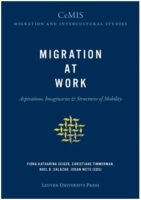Last Updated on September 1, 2021 by themigrationnews

“Migration at Work: Aspirations, Imaginaries & Structures of Mobility” is a volume published in 2020 which offers a multidisciplinary approach towards migration. This book comprises empirical research in various fields providing valuable scholarship and evidence on current processes of migration and mobility. A wide range of geographical coverage can be seen in the book chapters. To understand the importance of migration and mobility from a wider perspective, the research is conducted in European Union, Turkey, and South Africa. The narrative, descriptive and qualitative research study shows the methods to tackle experiences and aspirations of the migrants. The chapters thus analyse the labour-related mobilities from two distinct yet intertwined vantage points: the role of structures and regimes of mobility on the one hand, and aspirations as well as migrant imaginaries on the other (p. 15). All the authors and editors of this volume delve deeply into various aspects of migration with their expertise in various fields. This book unearths the questions such as: the role played by the opportunities when people are mobilising; how structures enable, sustain and change different forms of mobility and how imaginaries fuel labour migration and vice-versa. The book thus is divided into two parts that are related to either of the two vantage points. Both the parts contain four chapters each.
In the first chapter Aija Lulle discusses about the gap between migration literature and care which are to be bridged and should be critically read through the lens of care. Care is an important part in the lives of all. The chapter explains that existing structures such as European Union (EU), that has failed to consider migrants as caring agents and does not consider giving full social rights to temporary migrants. The main argument of this chapter is that migration is not only an economic activity but also a care-giving project. There are instances in the chapter where the migrant workers are not allowed to ask for leaves from their employers. Thus, author emphasises that the migrants are deprived of their right to make use of their mobility. There is a continuous negotiation from temporary migrants for their need to travel for providing care.
In second chapter, Joana de Sousa Ribeiro discusses the topic of health care migration. The chapter explores the interrelations between regulation regimes such as admission policies, academic institutions procedures, and professional bodies’ rules. Based on the case studies, the author brings out the debate of division between regulation and emancipation in a capitalist society. The findings suggest that social transformation poses new challenges to the structure of mobility. Further, this chapter explores on the inter and intra-relations of regulatory regimes related to the international mobility of the health workers to and from Portugal.
In third chapter, Alice Ncube and Faith Mkwananzi emphasise how migration has allowed female sub-Saharan economic migrants in South Africa to use their agency and challenge traditional gendered roles and stereotypes. The authors use the Capability Approach (CA) to understand how gendered roles are playing a part in reconstructing traditional structures that saw women as passive in development associated with labour migration (p. 68). This chapter highlights the fact that in earlier times, migration was thought to be for the men and the role of females were within the family and invisible to the world. Thus it gave the view that migration was a male centric phenomenon. Gradually, this assumption was changed and women could construct their path to development and break the glass ceiling. The findings illustrate that those women who have certain capabilities to migrate into a foreign country are exercising their agency in the field of work and earning for a living. . It is evident from the chapter that the nature of migration is not influenced by gender roles.
In chapter four, Mirjam Wajsberg tries to explore the tension between structure and agency experienced by West African migrants during their migration trajectories within Europe. The authors draw the attention where the migrants use tactics to achieve both spatial and socio-economic mobility despite various restrictions within the European Union. The migration trajectory approach used in this chapter allows us to understand the complex interplay between migrants’ hopes, frustrations and aspirations during their journeys. The chapter beautifully carves out the tactics used by the migrants who challenge the rules and regulations imposed on them.
In chapter five Maria Luisa Di Martino et al. examines how highly educated migrant women negotiate their careers considering structural constraints. The authors analyse their experiences of the educated migrant women through the lens of migratory careers. The chapter throws light by focusing on the coping strategies of European and Latin American women in the Basque Country. The findings show how opportunities and challenges are dealt with and how women despite facing structural constraints are getting opportunities when their private and professional trajectories unfold abroad.
In chapter six, Iraklis Dimitriadis explores hoe subjective representations of work or any type of life-related subjects may induce desires to leave the place of destination. This chapter further discusses about the decisions of the migrants to stay in their place of destination also. The author analyses how the lives of Albanian migrant construction workers in Italy and Greecerevolves around negative perceptions such as fears of racism or have to settle for less favourable lifestyles which works as deterrents for the migrants (p. 18). The author conducted 61 in-depth interviews with Albanian migrant construction workers in Italy and in Greece to conclude that the analysis of imaginaries can become the motivation for onward migration. The only limitation emerged in this study is from the gender perspective where Albanian migration is traditionally known as male pattern migration. It thus represents to confirm males’ prominent role in the household economy (p. 143).
In chapter seven, Christine Moderbacher focuses on the effects of future which is destroyed. The author describes the lived experiences of Cise whom he met and points out important nexus between imaginaries vested in mobility and structural realities. This study explores how certain migrants are systemically immobilised through governmentally prescribed training programmes. These programmes are typically used to keep the participants busy which eventually fail to convey skills that are applicable in the labour market. These policies are disabling people destroying their ability to imagine future horizons while at the same time producing a waiting room that turns people into “patients of the state” (p.166).
Finally in chapter eight, Deniz Berfin Ayaydin puts focus on the care in labour industry. The author argues that Filipino nannies are privileged in the hierarchy of foreign child-carers in Turkey. Accordingly, the placement agencies market Filipino women’s English-language proficiency; their modernity and their supposed cultural predisposition which can provide good childcare. This study however sheds light on the power relations which are formed during the course of migration. The author further explores how the privileges are distributed which are not equal to all in the care sector. The preferential treatment is clearly given to those with knowledge of English or higher level of work ethics instead of experience or age in the work domain.
The role of agency of migrants is often missing from an analysis of migration systems. The only drawback is repetitiveness. Some of the points in the chapters are repetitive and could have been eliminated to provide an easier read and avoid monotony. This book presented a breakthrough study on migration which is solely based on qualitative methods. This book thus opens up new possibilities for future research in the domain of migration. However the book is very informative in nature for anyone to read and gain knowledge about various aspects of migration. The aspects which the book covers are easy to read even for those who do not have any specific knowledge about migration. Overall, the book provides an excellent source of information for the students, researchers, policymakers or anyone who has interest in understanding migration.
Source: Fiona-Katharina Seiger, Christiane Timmerman, Noel B. Salazar, Johan Wets (2020), Migration at Work: Aspirations, Imaginaries & Structures of Mobility, Belgium: Leuven University Press, 978-94-6166344-3, 194 pages.

Bhowmick Piyali is a PhD scholar at the Tata Institute of Social Sciences, Guwahati Off Campus, India. She obtained MPhil degree in 2016 in Social Sciences from TISS Guwahati campus. She has done MA in Sociology in 2014 from Ambedkar University Delhi, New Delhi. Her areas of interest include- Labour Process, Manufacturing Industry, Sociology of everyday lives, Migration, Family and Kinship, Migration and Social networks.
